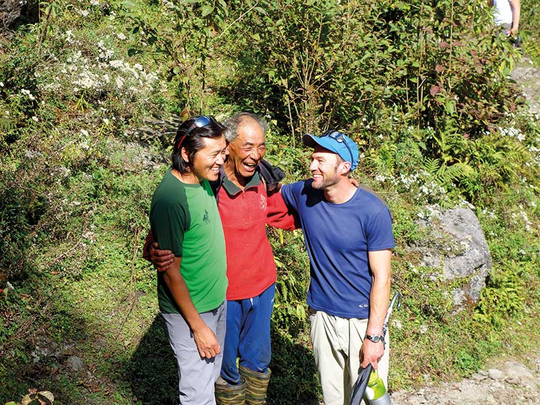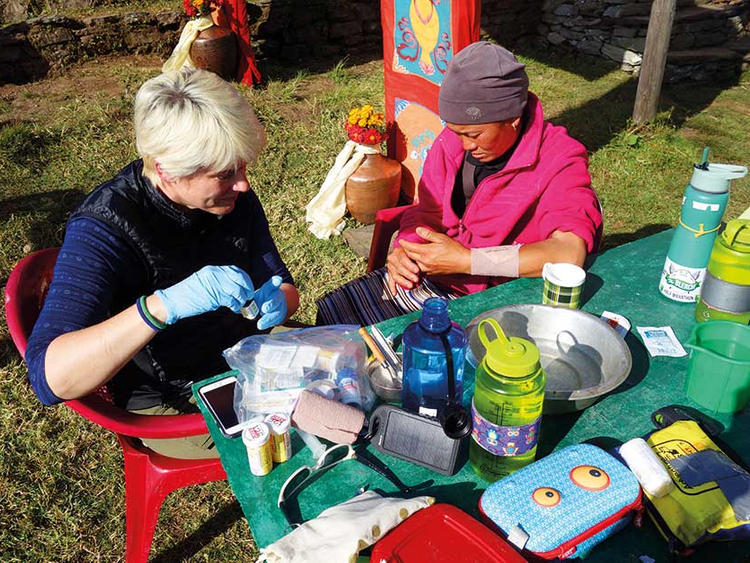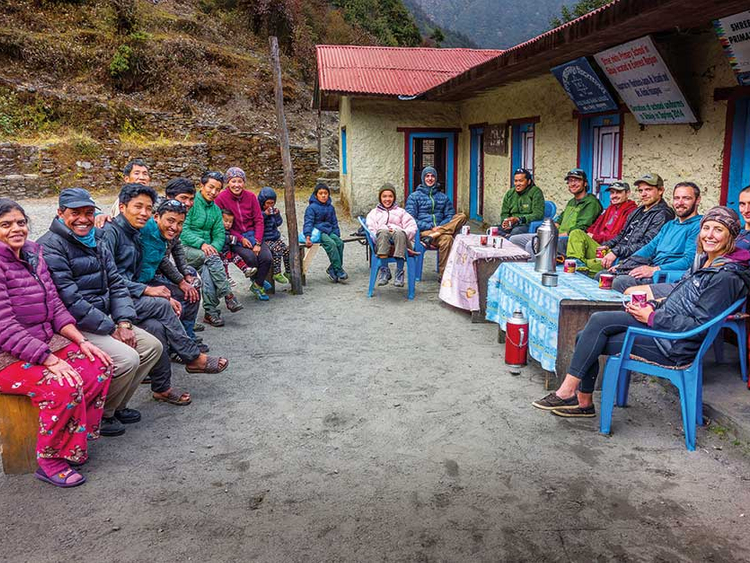
Da Tenji Sherpa was a mountain guide in Nepal who assisted mountaineers on several 8,000-metre peaks including Mount Everest. Despite having no formal training, he was very strong and well-adapted to high altitudes.
In 2016, he died on Makalu in the Himalayas, the fifth-highest mountain in the world. He and his partner died from carbon monoxide poisoning after using a stove inside an unventilated tent.
Back in the villages of these Nepali guides, there’s no electricity, no schools and a young generation is practically growing up in the dark. There are no doctors available in these villages, and even non-complicated medical concerns can lead to death. Sadly, stories such as these are common in the guiding community in Nepal.
Scaling the stunning peaks in this mountainous region is a dream for many across the globe. But for the Sherpa community, there is a pronounced risk to life for the guide and an uncertain future for his family members.
A desire to prevent tragic incidents like Da Tenji’s death pushed two enterprising individuals — Karma Geljen Sherpa and Glen Young — to work for the betterment of the community.
Karma comes from Sibuje, a hamlet in the far eastern side of Nepal, near Mera and Everest. When he was three-years-old, his father died from a bacterial infection. His mother remarried and Karma went on to have five half siblings. At the age of 15, Karma moved to Lukla, a nearby town where tourists typically first arrive en route to the Everest base camps, to work as a porter. That means regularly hauling up loads that can weight up to 37 kg for expeditioners.
“I started earning 80 Nepali rupees (Dh2.66 ) per day,” he says. “It was hard work, considering I was walking without shoes.” But determined that he was, Karma fought his way up through the ranks to eventually become an expedition leader — a Sirdar.
Young, an American, has been working in the mountain-guiding industry for several years, leading trips around the world, from Alaska and Ecuador to New Zealand, and it was during one such expedition to Nepal that he met Karma Sherpa.
“I remember seeing Karma from across the Dhurbar Square in Kathmandu, wearing a dark softshell jacket sporting many company logos as if he were a sponsored mountain athlete,” Young tells Weekend Review. “He was much shorter than I was, but his thin athletic frame and confident posture made him seem to be my height. Karma had come to meet me because his uncle was guiding on the north side of Everest and was unavailable. I took Karma to lunch and we chatted about his life in Sibuje. He had grown up on a subsistence farm and had paid for his sisters’ education by working as a porter. Although Karma did not speak much English at the time, and I spoke no Nepali or Sherpani — the language of the Sherpa people — we easily formed a friendship.”
Sherpa life is tough, and the predominantly inclement weather makes it worse.
Karma moved his base to Kathmandu and now travels to Sibuje for work and to meet his parents and family. Back there, there is only one government school which runs until Grade 3 and the high school is four hours away; there are no telephones and no electricity. Of late, the village has been mostly managing on solar power. With cloudy weather prevailing, the homes are heated and lit by wood fires.
Karma’s two brothers are also guides and have summited Everest twice, while he has reached the 8,000-metre height three times.
“As an American working in the mountain guiding industry, I was initially surprised by the work of guides in Nepal,” Young says. “Guides in the US generally have extensive training and have to pass exams and hold certification to obtain work in the Himalayas. Although things are slowly changing, this was rarely the case when I began running trips in Nepal in 2008. The opportunity to work as a guide was more dependent on family connections to expedition company owners and access to clients than to training or experience.”
Due to the cost of equipment relative to the local wage, it is also difficult for Nepalese guides to own their own climbing equipment and clothing. “For example, a down suit, harness, jummar, and 8,000-metre expedition boots are standard equipment for climbs of high elevation peaks,” Young says. “Together, this equipment costs more than what many Nepalese earn in an entire year. Nepalese guides working on Mount Everest may spend more than half of their earnings on purchasing the gear they need for the climb, even though expedition companies often provide the most expensive items, such as down suits, free of charge.”
Talking to Karma, Young quickly realised that they could make improvements.
“In 2011, when I visited Sibuje with Karma and my friend Bonom Bohanec, I saw many of the strengths and weaknesses of my own community back home,” Young says. “People were hardworking, welcoming and kind. There were also problems such as alcoholism, a lack of access to education and medical services, and few employment opportunities. At the end of my stay, Karma asked if I could help by raising money for a micro-hydro project to provide electricity for the village. Although I had no expertise in fundraising or hydro-power, I promised Karma I would help any way I could. Karma had once told me that one of his greatest dreams was to own his own tourism company so he could employ the people in his village.”
Young realised that this would be a way to address some of the underlying problems within the village, all-at-once.
“Bonom paid the government fees for Karma to register a tourism agency which he called Higher Path Treks,” Young says. “Karma and I made plans to direct profits from the tourism company into village infrastructure and services, and I laid out a plan to provide training and equipment to locals who were in need of work. And thus, Karma Project was born.”
What Karma Project essentially does is raise funds for the various multi-level activities in Sibuje. It has provided school uniforms to all students in the village each year and provides a 50 per cent scholarship for high school education, funded trail reconstruction and maintenance as walking is the only way to reach the village. It has also installed a water connection, provided training to men and women to work as guides and cooks on treks and climbs, paid for English-language training of some, and funded reconstruction of damaged homes and buildings after the 2015 earthquake.
Guests from the US are encouraged to opt for a homestay so that the women can generate income as well.
“The people of Sibuje are very happy that the project has changed their life for the better,” Karma says. “We have partially funded the routing of electric cables from an existing hydroelectric dam to the village. That project needs $16,000 for completion. Even smallest contribution makes a difference, and we are hopeful of raising more funds.”
Additionally, Karma’s tourism agency also ensures that guides carry loads not more than 20-25 kg each and provides insurance — something that other tourism companies don’t do.
Tourism is the mainstay of the Sherpa community and the local environment needs to be cared for for the business to thrive.
Landslides are common during monsoons, and rampant deforestation is only aggravating the problem. Villagers too need to walk long distances to gather wood and, especially in winters, the situation is critical.
Young believes sustainable tourism is the way forward, providing long-lasting, meaningful relationships between locals, tourists and the environment.
“There is a real feeling of connection, concern and respect in this form of tourism that I hope gradually overshadows forms of tourism where connections between local people and visiting tourists are mostly through the lens of a camera”, Young says. And the people of Sibujle are buying into the plan. With more and more students able to attend school, they returned to the village with new ideas on how to reduce the environmental impact and improve sanitation.
With money now available in the community through employment and project funds from the Karma Project, several solutions could be put into place.
Now more than half of the homes in Sibuje have squat toilets. These now compost human waste, which is then used primarily in the forest where free-ranging animals graze. It’s a delicate balance but the village is making progress.
Pema Angi Sherpa was given a scholarship by Karma Project in 2014 to study medicine in Kathmandu so she could provide medical and healthcare to her community in Sibuje. Previously, there had been attempts to establish health posts in several nearby communities but none were successful because doctors and nurses who staffed the clinics were not from the area, did not speak the local language, and found the positions isolated and lonely. This meant that the closest clinic was a three-day walk away on difficult mountain trails, and many patients died while being carried there on the backs of others After her training, Pema Angi was able to speak on the phone with village folk in Sherpani and address health concerns. When she visits her family in the village she also provides free healthcare visits. Pema’s education and training allowed her to gain employment at a hospital in Lukla, and she has been able to visit the US for an internship at a New York hospital.
“Like Karma, Pema Angi used the opportunities she gained through Karma Project to improve not only her own life but the lives of everyone in the community where she was born”, Young says.
Karma Project is registered as a non-profit organisation in the US, and what resonates with the donors is that the Sibuje Community Council, which is just a group of random villagers who are available during the meetings, determine the project needs and resources. This method of fairness works simply because the community functions on a democratic basis. When donations of clothing and gifts are given to the village, for example, the packages are divided into piles of equal value, and a number is placed on top of each pile. Numbers are then placed in a hat, and each family draws out a number to determine who will get each pile.
With bigger plans of generating sustainable tourism businesses among other initiatives such as salaries for teachers at a local school and providing internationally recognised training courses for those who work as professional mountain guides, for all living in Sibuje, things are looking up.
Manasi Mathkar is a writer based in Manila.














